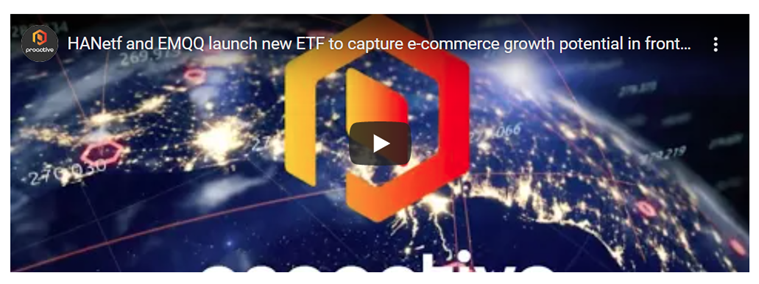India: A future leader in e-commerce and tech platforms?

You cannot talk about the investment case for India without first mentioning the country’s rapid economic growth. India’s economy grew at an average rate of 7.7% in the past two decades.1
Kevin Carter, manager of FMQQ Next Frontier Internet & Ecommerce ESG-S UCITS ETF (FMQQ)
The country’s economy is also rapidly recovering from the pandemic-induced contraction. India’s economy grew by 8.4 percent year-on-year in July-September 2021 after a record 20.1 percent growth in the previous three-month period.2
This growth has also been accompanied by a massive rise in incomes that has lifted hundreds of millions out of poverty, adding to the global middle class.3 According to a study by Brookings Research, India only accounted for 5% of the global middle class as of 2015. However, that percentage is estimated to grow to 9% in 2020 and 17% in 2030.4
With this comes rising consumption. India has been showing steady consumption growth for several years. It is expected that consumption in India will triple by 2030. According to Boston Consulting Group, “growth has been driven by strong fundamentals – increasing share of affluent and elite households, urbanization, nuclearization of households and increasing Gen-I population with higher appetite to spend.”5
‘It is expected that consumption in India will triple by 2030’
India is also increasingly coming online. In 2019, a report found that over 500 million Indians smartphones. That was an increase a 15% increase from 2018, largely due to due to the growing availability of cheaper brands such as Xiaomi and Realme.6 Our own projected rate of smartphone adoption stands at approximately 4,000 freshly minted smartphone users in India every hour, representing a significantly growing user base for companies to capture.
On top of that, there are now 560 million internet users in India, making it the second largest online market in the world, second only to China. It has been estimated that by 2023, that number will grow to 650 million.
So here we have two trends. First, a population getting wealthier, with higher incomes and ability to spend on consumption. Second, a population that is increasingly connected and online. Taken together, this suggests the potential for greater consumerism in general, and strong growth in commerce specifically. Just as our consumption patterns have changed via the internet and smartphone, so too are those in the developing economies of the world.
‘And indeed the Indian ecommerce industry has soared, even more so after a surge in digital adoption during the pandemic’
And indeed the Indian ecommerce industry has soared, even more so after a surge in digital adoption during the pandemic. Ecommerce is estimated to account for 25% of the India’s total retail market, with projections suggesting this could reach 37% by 2030. The Indian ecommerce market was estimated to be worth over $55 billion in Gross Merchandise Value in 2021. By 2030 that is expected to rise to $350 bn.7
But the key question for investors is where will all this money be spent? If Indian e-commerce consumers opt established big name e-commerce platforms such as Amazon or Alibaba, that does not present much of an opportunity for investing Indian equities. However, this is not the case.
Currently, Indian government policy is to support domestic competitors in the e-commerce space. Indeed, Narendra Modi, the prime minister of India, appears to be moving in the Chinese direction of protectionist policies as he recognizes the incredible domestic potential to incubating homegrown names over global rivals.8
As a result, rather than Chinese or US firms filling the gap, increasingly local entrepreneurs are doing so. As Brookings notes: “Homegrown entrepreneurs are uniquely positioned to take advantage of the digital trade opportunity.”9
This can be seen in the huge growth in valuation of Indian e-commerce firms in recent years, as well as a flurry of initial public offerings (IPO). According to GlobalData, a total of six e-commerce companies listed in India between 2019 and 2021. In 2019, there were just two Indian e-commerce firms publicly listed.
The trend is likely to continue 2022, with several major ecommerce companies expected to go public.10 There are now 20 unlisted Indian e-commerce companies with a valuation of over $1billion. Of these 20, 11 reached unicorn status in 2021.11
The wider Indian tech space is also booming beyond just e-commerce. A total of 81 unlisted Indian tech companies can be classified as unicorns, with 44 reaching this status in 2021. Last year saw India overtake United Kingdom in terms of the number of unlisted companies valued at $1 billion, sitting in third place globally.12
1 Next 10 years make-or-break decade for Indian economy: Economists – The Economic Times (indiatimes.com)
2 India GDP Annual Growth Rate | 2022 Data | 2023 Forecast | 1951-2021 Historical (tradingeconomics.com)
3 The World Bank https://www.worldbank.org/en/country/india/overview
4 global_20170228_global-middle-class.pdf (brookings.edu)
5 bcg-rai-report-retail-resurgence-in-india.pdf 6 Smartphone Users in India Crossed 500 Million in 2019, States Report (news18.com)
7 E-commerce Industry in India – Market Size, Opportunities, Growth (investindia.gov.in)
8 Protectionism in India: How New eCommerce Laws Will Impact Brands (scalefast.com)
9 The emerging markets e-commerce opportunity (brookings.edu)
10 Indian ecommerce IPO market to stay strong in 2022 – Verdict
11 India now has four healthtech unicorns | BusinessInsider India
12 Fintech remains the rage | BusinessInsider India
More information about FMQQ here >
FMQQ Next Frontier Internet & Ecommerce ESG-S UCITS ETF – Acc
‘FMQQ can be an attractive alternative for investors who want to capture the budding opportunities in these ‘next frontier’ markets and/or complement their Chinese tech allocations and balance out their current portfolio weightings.’ – Kevin T. Carter, Founder, EMQQ
Important Information:
Communications issued in the UK (ETFs and ETCs)
The content in this document is issued by HANetf Limited (“HANetf”) and approved by Privium Fund Management (UK) Limited (“Privium”). HANetf are an appointed representative of Privium, which is authorised and regulated by the Financial Conduct Authority.). HANetf is registered in England and Wales with registration number 10697042.
Communications issued in the European Economic Area (“EEA”) relating to ETFs
The content in this document is issued by HANetf Management Limited (“HML”) acting in its capacity as management company of HANetf ICAV. HML is authorised and regulated by the Central Bank of Ireland. HML is registered in Ireland with registration number 621172.
Communications issued in the EEA relating to ETCs
The content in this document is issued by Walnut Financial Services B.V. and OAKK Capital Partners B.V. (“OAKK”), an investment firm authorized and regulated by the Authority for the Financial Markets in The Netherlands. OAKK is registered in the Netherlands with registration number 24425154.
The Issuers
HANetf ICAV, an open-ended Irish collective asset management vehicle issuing under the terms in the Prospectus and relevant Supplement for the ETF approved by the Central Bank of Ireland (“CBI”) (“ETF Prospectus”) is the issuer of the ETFs. Investors should read the current version of the ETF Prospectus before investing and should refer to the section of the ETF Prospectus entitled ‘Risk Factors’ for further details of risks associated with an investment in the ETFs. Any decision to invest should be based on the information contained in the ETF Prospectus.
HANetf ETC Securities plc, a public limited company incorporated in Ireland, issuing:
the precious metals ETCs under the terms in the Base Prospectus approved by both the Central Bank of Ireland (“CBI”), the UK Financial Conduct Authority (“FCA”) (“ETC Prospectus”) and the final terms of the relevant precious metals series (together, “ETC Securities Documentation”); and
the carbon securities ETCs under the terms in the Base Prospectus approved by the FCA (“FCA ETC Prospectus”) and the final terms of the relevant carbon allowance (together, “FCA ETC Securities Documentation”).
Investors should read the latest versions of the ETC Securities Documentation and the FCA ETC Securities Documentation before investing and should refer to the section of the Base Prospectuses entitled ‘Risk Factors’ for further details of risks associated with an investment in the ETCs. Any decision to invest should be based on the information contained in the ETC Securities Documentation and the FCA ETC Securities Documentation.
ETC Issuance GmbH, a limited liability company incorporated under the laws of the Federal Republic of Germany, issuing under the terms in the Prospectus approved by the Bundesanstalt für Finanzdienstleistungsaufsicht (“BaFin”) and the final terms (“Cryptocurrency Prospectus”) is the issuer of the ETCM ETCs. Investors should read the latest version of the Cryptocurrency Prospectus before investing and should refer to the section of the Cryptocurrency Prospectus entitled ‘Risk Factors’ for further details of risks associated with an investment in the ETCs contained in the Cryptocurrency Prospectus. Any decision to invest should be based on the information contained in the Cryptocurrency Prospectus.
The ETF Prospectus, ETC Securities Documentation, FCA ETC Securities Documentation and Cryptocurrency Prospectus can all be downloaded from www.hanetf.com.
This communication has been prepared for professional investors, but the ETCs and ETFs set out in this communication (“Products”) may be available in some jurisdictions to any investors. Please check with your broker or intermediary that the relevant Product is available in your jurisdiction and suitable for your investment profile.
Past performance is not a reliable indicator of future performance. The price of the Products may vary and they do not offer a fixed income.
This document may contain forward looking statements including statements regarding our belief or current expectations with regards to the performance of certain assets classes. Forward looking statements are subject to certain risks, uncertainties and assumptions. There can be no assurance that such statements will be accurate and actual results could differ materially from those anticipated in such statements. Therefore, readers are cautioned not to place undue reliance on these forward-looking statements.
The content of this document is for information purposes and for your internal use only, and does not constitute an investment advice, recommendation, investment research or an offer for sale nor a solicitation of an offer to buy any Product or make any investment.
The decision and amount to invest in any Product should take into consideration your specific circumstances after seeking independent investment, tax and legal advice. We do not control and are not responsible for the content of third-party websites.
We believe the information in this document is based on reliable sources, but its accuracy cannot be guaranteed. The views expressed are the views of Hanetf at time of publication and may change. Neither Privium nor HANetf is liable for any losses relating to the accuracy, completeness or use of information in this communication, including any consequential loss.
Read the latest edition of DIY Investor Magazine
DIY Investor Magazine
The views and opinions expressed by the author, DIY Investor Magazine or associated third parties may not necessarily represent views expressed or reflected by EQi.
The content in DIY Investor Magazine is non-partisan and we receive no commissions or incentives from anything featured in the magazine.
The value of investments can fall as well as rise and any income from them is not guaranteed and you may get back less than you invested. Past performance is not a guide to future performance.
DIY Investor Magazine delivers education and information, it does not offer advice. Copyright© DIY Investor (2016) Ltd, Registered in England and Wales. No. 9978366 Registered office: Mill Barn, Mill Lane, Chiddingstone, Kent TN8 7AA.



